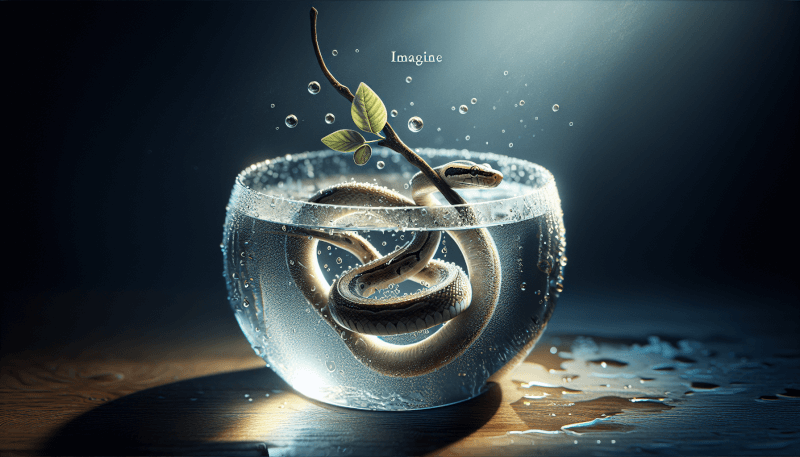Have you ever wondered how to ensure your pet snake stays healthy and hydrated? Look no further! In this article, we will explore the best ways to provide fresh water for your snake. From choosing the right water source to maintaining optimal water quality, we’ve got you covered. Keeping your snake hydrated is essential for its overall well-being, so let’s dive into these helpful tips and tricks together.

Selecting the Right Water Source
When it comes to selecting the right water source for your snake, there are several options to consider. Each source has its own advantages and potential drawbacks, so it’s important to choose one that meets your snake’s specific needs.
Tap Water
Tap water is a readily available and convenient option for providing water to your snake. However, it’s important to note that the quality of tap water can vary depending on where you live. Some tap water may contain chemicals or impurities that could be harmful to your pet snake. If you plan to use tap water, it’s recommended to use a water conditioner or dechlorinator to remove any harmful substances.
Filtered Water
Filtered water can be a great option for providing clean and safe water for your snake. Filtration systems can remove impurities and chemicals from tap water, ensuring that your snake has access to high-quality water. It’s important to choose a filter that is specifically designed for reptile use and to regularly replace the filter cartridges to maintain optimal water quality.
Bottled Spring Water
Bottled spring water is another option to consider for your snake’s water source. It typically undergoes a filtration process to remove impurities and is often enriched with minerals. However, it’s essential to read the label and choose a brand that does not add any additional substances, such as fluoride or other chemicals, that could be harmful to your snake.
Distilled Water
Distilled water is water that has been boiled and then cooled, leaving behind impurities and minerals. While it may seem like a clean option, it’s important to note that distilled water lacks essential minerals that snakes need for proper hydration. As a result, it’s not recommended to use distilled water as the primary water source for your snake.
Rainwater
Rainwater can be a natural and cost-effective option for providing water to your snake. However, it’s important to collect rainwater in clean containers and to avoid collecting water after heavy rainfall, as it may contain contaminants. Additionally, rainwater should be tested regularly for water quality and adjusted if necessary.
Choosing the Appropriate Water Container
Once you have selected the right water source for your snake, it’s crucial to choose an appropriate water container that meets their needs. There are several options to consider, each with its own advantages and potential drawbacks.
Water Bowls
Water bowls are a common choice for providing water to snakes. They are typically made of ceramic or plastic and come in various sizes. When choosing a water bowl, opt for one that is heavy and sturdy to prevent tipping and spilling. It’s essential to clean the water bowl regularly to maintain water quality and prevent the growth of bacteria.
Water Dishes
Water dishes are similar to water bowls but are typically made of stainless steel. They are easy to clean and sanitize, making them a hygienic option for your snake’s water source. Additionally, stainless steel water dishes are resistant to scratches, which can harbor bacteria.
Water Bottles
Water bottles can be a useful option for snakes that prefer to drink from a dripping or flowing water source. Available in various sizes and designs, water bottles allow for consistent and controlled water delivery. However, it’s important to clean and refill the water bottle regularly to prevent bacterial growth and ensure a fresh water supply.

Ensuring the Right Water Temperature
Providing water at the right temperature is essential for your snake’s overall health and well-being. Snakes prefer to drink water that is at a specific temperature range, and understanding this optimal temperature is crucial for their hydration.
Understanding Optimal Temperature
The optimal water temperature for snakes typically falls between 75-85 degrees Fahrenheit. This temperature range is similar to their natural environment and encourages proper hydration. Water that is too cold or too warm may discourage snakes from drinking, leading to dehydration.
Using a Thermometer
To ensure that the water temperature is within the optimal range, it’s recommended to use a thermometer to regularly monitor the water temperature. Place the thermometer in the water container or immerse it in the water for accurate readings. If the water temperature is outside the optimal range, you can make necessary adjustments to provide water at the desired temperature.
Adjusting Temperature as Needed
If the water temperature is too cold, you can use a reptile-safe water heater or place the water container near a heat source to warm it. On the other hand, if the water temperature is too warm, you can add ice cubes or place the water container in a cooler area to cool it down. It’s important to regularly check the water temperature to maintain optimal conditions for your snake’s hydration.
Providing Sufficient Water Amount
Ensuring that your snake has access to a sufficient amount of water is crucial for their hydration and overall health. To determine their water consumption and calculate the required water volume, it’s important to understand your snake’s specific needs.
Determining Snake’s Water Consumption
The water consumption of snakes can vary depending on factors such as species, age, size, and environmental conditions. Some snakes may drink more water than others, so it’s essential to observe your snake’s water intake to get a sense of their individual needs. Additionally, monitoring their behavior and overall health can provide insights into their hydration levels.
Calculating Required Water Volume
Once you have determined your snake’s water consumption, you can calculate the required water volume. As a general guideline, it’s recommended to provide a water container large enough for your snake to soak in comfortably. Snakes may also prefer larger containers that allow them to submerge their entire body, especially during shedding periods.
Regularly Checking and Refilling
To ensure that your snake always has access to fresh water, it’s crucial to regularly check the water container and refill it as needed. Depending on your snake’s water consumption, you may need to refill the water container daily or every few days. It’s important to clean the water container and provide fresh water every time you refill it to maintain water quality.

Preventing Water Contamination
Keeping your snake’s water supply clean and free from contaminants is essential for their health and well-being. By following these practices, you can prevent water contamination and ensure a safe drinking environment for your snake.
Avoiding Chemical Contaminants
To prevent chemical contamination, it’s important to avoid using water containers made of materials that may leach harmful chemicals into the water. Ceramic, stainless steel, or reptile-safe plastic containers are recommended options. Additionally, ensure that the water source itself is free from chemicals or pollutants that could potentially harm your snake.
Cleaning Water Container Regularly
Regularly cleaning the water container is crucial for preventing the growth of bacteria and maintaining water quality. Empty the water container and wash it thoroughly with warm water and a reptile-safe cleaning agent. Avoid using harsh chemicals or detergents that could harm your snake. Rinse the container thoroughly before refilling it with fresh water.
Using Reptile-Safe Cleaning Agents
When cleaning the water container, it’s important to use reptile-safe cleaning agents specifically designed for reptile enclosures. These cleaning agents are formulated to remove bacteria and impurities while being safe for reptiles. Avoid using household cleaning products, as they may contain chemicals that could be harmful to your snake if ingested.
Creating a Natural Water Environment
Mimicking a natural water environment for your snake can encourage drinking and provide an enriching experience. By adding decorative elements and water features, you can create a more appealing water source for your snake.
Mimicking Natural Habitat
Snakes are naturally found near bodies of water in the wild, so incorporating natural elements into their water environment can help create a more natural habitat for them. Adding rocks, branches, or artificial plants around the water container can provide hiding spots and create a more appealing drinking environment.
Adding Decorative Elements to Encourage Drinking
To encourage your snake to drink more water, you can add decorative elements to the water container. Floating objects like cork bark or leafy greens can be enticing and encourage your snake to explore and drink from the water source. However, it’s important to regularly clean these decorative elements to prevent bacteria or mold growth.
Using Water Features for Increased Humidity
If your snake requires higher humidity levels, incorporating water features such as small fountains or misting systems can help increase humidity in the enclosure. These water features not only provide a water source for your snake but also contribute to the overall humidity levels in their habitat.

Monitoring and Maintaining Water Quality
Regular monitoring of your snake’s water quality is essential for their health and well-being. By conducting water quality tests, adjusting pH and hardness levels if needed, and installing water filters or purifiers, you can ensure that your snake has access to clean and safe water.
Regular Water Quality Testing
Performing regular water quality tests using aquarium test kits can help you monitor the chemical levels and overall quality of the water. Test for parameters such as pH, ammonia, nitrate, and nitrite levels to ensure that your snake’s water meets the appropriate standards. Conduct these tests periodically and take necessary steps to adjust any imbalances or issues.
Adjusting pH and Hardness if Needed
Some snake species may require specific pH levels or water hardness to maintain optimal health. If the water quality tests reveal imbalances in pH or hardness levels, you can adjust them by using reptile-safe water conditioners or pH adjusters. It’s important to follow the product instructions carefully and slowly make any necessary adjustments to avoid sudden changes that may stress your snake.
Installing Water Filters or Purifiers
To maintain water quality and remove impurities, installing water filters or purifiers can be beneficial. These devices can effectively remove chlorine, heavy metals, and other contaminants from the water, ensuring a cleaner water source for your snake. Choose filters or purifiers designed specifically for reptiles to avoid any potential harm to your snake.
Considering Specific Snake Species
Different snake species may have specific water needs and preferences. It’s important to research the water requirements of your snake’s species to ensure that you are providing the appropriate water delivery method.
Researching Species-Specific Water Needs
Each snake species may have unique water requirements based on their natural habitat and behavior. Some snakes prefer to soak in shallow water, while others may prefer a dripping water source. Research your snake’s species to understand their specific water needs and adjust their water environment accordingly.
Adapting Water Delivery Method
Depending on your snake’s species, you may need to adapt the water delivery method. For snakes that prefer soaking, provide a shallow water bowl that allows them to submerge their body. For species that prefer a dripping water source, consider using a water bottle or creating a drip system that provides a constant flow of water.
Understanding Behavioral Water Requirements
In addition to species-specific water needs, it’s essential to understand your snake’s behavior when it comes to water consumption. Some snakes may be more active drinkers and require a larger water container, while others may drink less frequently. Observing your snake’s behavior and adjusting their water environment accordingly can help ensure that their hydration needs are met.

Managing Water during Shedding
Snakes require increased humidity levels during shedding periods to facilitate the shedding process. By implementing specific strategies, you can help maintain optimal humidity levels and provide additional hydration for your snake.
Increasing Humidity Levels
During shedding periods, it’s important to increase the humidity levels in your snake’s enclosure. You can achieve this by misting the enclosure with water or by adding a humidity hide. A humidity hide is a shelter with damp moss or substrate that your snake can use to increase moisture levels around its body.
Providing a Soaking Container
Offering a soaking container during shedding periods can provide your snake with an additional source of hydration. A shallow container filled with warm water should be provided for your snake to soak in. It’s important to monitor your snake during soaking to ensure their safety and remove the container once they are done.
Offering a Moist Hide
A moist hide is another option to help maintain humidity levels and provide hydration for your snake during shedding. A hide box filled with damp sphagnum moss or coconut fiber can create a microclimate of increased moisture, allowing your snake to seek out the humidity it needs during shedding.
Understanding Signs of Dehydration
Recognizing the signs of dehydration in your snake is crucial for early intervention and prevention of health issues. By understanding these signs and taking immediate steps to rehydrate your snake, you can ensure their well-being.
Recognizing Common Symptoms
Some common symptoms of dehydration in snakes include lethargy, wrinkled skin, sunken eyes, loss of appetite, and dry or sticky mouth. If you observe any of these symptoms in your snake, it’s important to take immediate action to rehydrate them.
Taking Immediate Steps to Rehydrate
If your snake shows signs of dehydration, offer them fresh water in a shallow bowl or a soaking container. Ensure that the water is at an appropriate temperature and monitor your snake’s response. If their symptoms persist or worsen, it’s crucial to seek veterinary assistance.
Consulting a Veterinarian if Necessary
If you are unsure about your snake’s hydration levels or if their symptoms are severe, it’s best to consult with a veterinarian who specializes in reptiles. They can provide a thorough examination, offer advice on hydration techniques, and recommend appropriate treatments if necessary.
In conclusion, providing fresh water for your snake is essential for their overall health and well-being. By selecting the right water source, choosing appropriate water containers, ensuring the right water temperature, providing sufficient water amounts, preventing water contamination, creating a natural water environment, monitoring water quality, considering specific snake species, managing water during shedding, understanding signs of dehydration, and taking immediate action when necessary, you can ensure that your snake stays properly hydrated and thriving. Remember to always prioritize your snake’s hydration needs and consult a veterinarian for any concerns or questions regarding their water intake.


